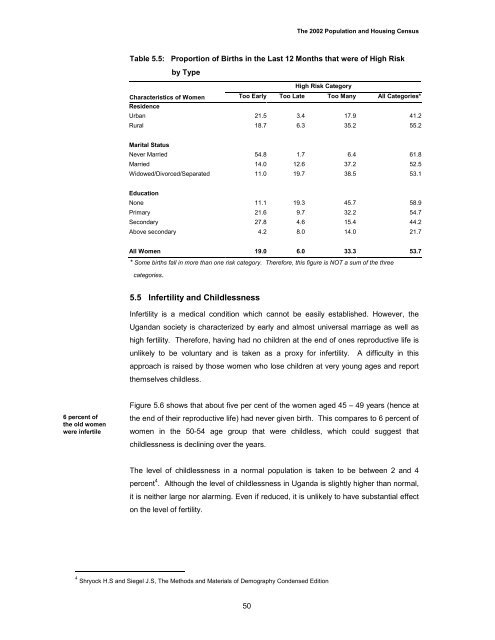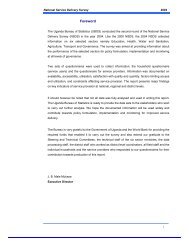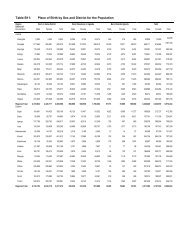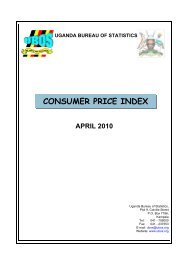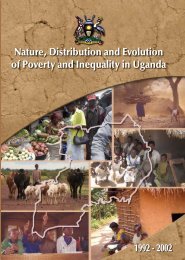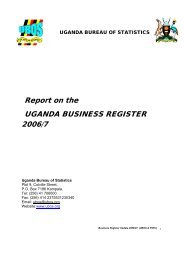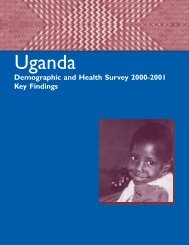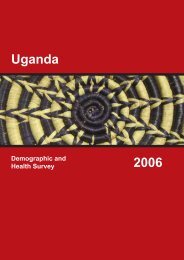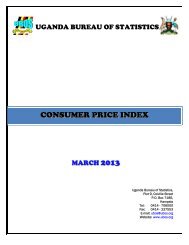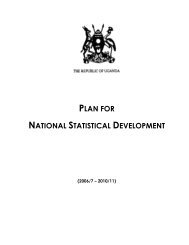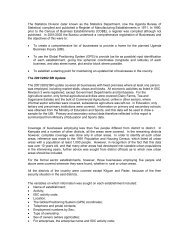Census Analytical Report - Uganda Bureau of Statistics
Census Analytical Report - Uganda Bureau of Statistics
Census Analytical Report - Uganda Bureau of Statistics
Create successful ePaper yourself
Turn your PDF publications into a flip-book with our unique Google optimized e-Paper software.
The 2002 Population and Housing <strong>Census</strong>Table 5.5: Proportion <strong>of</strong> Births in the Last 12 Months that were <strong>of</strong> High Riskby TypeHigh Risk CategoryCharacteristics <strong>of</strong> Women Too Early Too Late Too Many All Categories*ResidenceUrban 21.5 3.4 17.9 41.2Rural 18.7 6.3 35.2 55.2Marital StatusNever Married 54.8 1.7 6.4 61.8Married 14.0 12.6 37.2 52.5Widowed/Divorced/Separated 11.0 19.7 38.5 53.1EducationNone 11.1 19.3 45.7 58.9Primary 21.6 9.7 32.2 54.7Secondary 27.8 4.6 15.4 44.2Above secondary 4.2 8.0 14.0 21.7All Women 19.0 6.0 33.3 53.7* Some births fall in more than one risk category. Therefore, this figure is NOT a sum <strong>of</strong> the threecategories.5.5 Infertility and ChildlessnessInfertility is a medical condition which cannot be easily established. However, the<strong>Uganda</strong>n society is characterized by early and almost universal marriage as well ashigh fertility. Therefore, having had no children at the end <strong>of</strong> ones reproductive life isunlikely to be voluntary and is taken as a proxy for infertility. A difficulty in thisapproach is raised by those women who lose children at very young ages and reportthemselves childless.Figure 5.6 shows that about five per cent <strong>of</strong> the women aged 45 – 49 years (hence at6 percent <strong>of</strong>the old womenwere infertilethe end <strong>of</strong> their reproductive life) had never given birth. This compares to 6 percent <strong>of</strong>women in the 50-54 age group that were childless, which could suggest thatchildlessness is declining over the years.The level <strong>of</strong> childlessness in a normal population is taken to be between 2 and 4percent 4 . Although the level <strong>of</strong> childlessness in <strong>Uganda</strong> is slightly higher than normal,it is neither large nor alarming. Even if reduced, it is unlikely to have substantial effecton the level <strong>of</strong> fertility.4 Shryock H.S and Siegel J.S, The Methods and Materials <strong>of</strong> Demography Condensed Edition50


